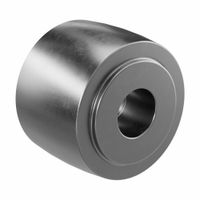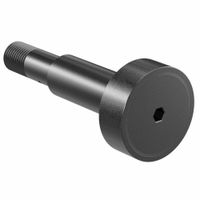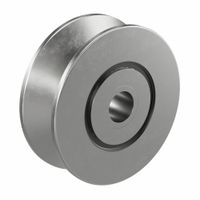Call +(254) 703 030 000 / 751 483 999 / 721 704 777
- Home
- Power Transmission
- Bearings
- Cam Followers Track Rollers
.....Read More
Frequently Asked Questions
What are cam followers and track rollers?
Cam followers and track rollers are specialized types of rolling-element bearings designed to follow cam lobes or tracks, providing linear or rotational motion in various mechanical systems.
Cam Followers:
- Cam followers are a type of needle or roller bearing with a stud or yoke mount. They are designed to follow the cam lobe's profile, converting rotary motion into linear motion.
- They consist of a thick-walled outer ring, needle or cylindrical rollers, and a stud or yoke for mounting.
- The outer ring is designed to handle high radial loads and reduce deformation under stress.
- Cam followers are used in applications like automated machinery, conveyors, and material handling systems, where they provide precise motion control and reduce friction.
Track Rollers:
- Track rollers are similar to cam followers but are specifically designed to run on tracks or rails, providing smooth and reliable motion.
- They can have a cylindrical or crowned outer surface to accommodate misalignment and reduce edge loading.
- Track rollers are available in various configurations, including single or double row, and can be mounted on shafts or studs.
- They are used in applications such as rail systems, sliding doors, and heavy-duty conveyor systems, where they support and guide loads along a predetermined path.
Both cam followers and track rollers are essential in mechanical systems requiring precise motion control, high load capacity, and durability. They are available in different materials, sizes, and configurations to suit specific application needs, ensuring efficient and reliable operation in various industrial and commercial settings.
How do cam followers and track rollers work?
Cam followers and track rollers are specialized bearings designed to follow the contours of a cam or track, converting rotary motion into linear motion or following a defined path.
Cam followers consist of a thick-walled outer ring, a stud or shaft, and needle or cylindrical rollers. The outer ring is designed to withstand heavy loads and reduce deformation. The rollers inside the cam follower allow for smooth rotation and minimize friction. The stud or shaft is mounted to a machine component, allowing the cam follower to roll along a cam profile or track.
Track rollers are similar but are typically used in applications where they follow a linear track. They have a similar construction with an outer ring and internal rolling elements, but they may have flanges or crowned outer surfaces to better handle misalignment and reduce edge stresses.
Both cam followers and track rollers work by translating the motion of the cam or track into a controlled movement. As the cam rotates, the cam follower rolls along its surface, translating the cam's profile into linear motion. This is crucial in applications like automated machinery, conveyors, and material handling systems, where precise motion control is required.
The design of cam followers and track rollers allows them to handle high radial loads and some axial loads, making them suitable for heavy-duty applications. They are often used in environments where shock loads and misalignment are common, thanks to their robust construction and ability to accommodate slight deviations in alignment.
In summary, cam followers and track rollers are essential components in mechanical systems that require precise motion control, converting rotary motion into linear motion or following a specific path with minimal friction and high load capacity.
What are the differences between cam followers and track rollers?
Cam followers and track rollers are both types of rolling element bearings, but they have distinct differences in design and application:
1. **Design and Structure**:
- **Cam Followers**: Typically have a thick-walled outer ring that can handle high radial loads and reduce deformation. They often include a stud or yoke for mounting, with the stud type having an integral shaft and the yoke type being mounted on a separate shaft.
- **Track Rollers**: Generally have a thinner outer ring compared to cam followers and are designed to run on flat surfaces or tracks. They can be mounted on shafts or axles and often have a crowned outer surface to reduce edge stresses.
2. **Load Capacity**:
- **Cam Followers**: Designed to handle both radial and axial loads, making them suitable for applications with combined loading conditions.
- **Track Rollers**: Primarily designed to handle radial loads, with limited axial load capacity.
3. **Applications**:
- **Cam Followers**: Commonly used in cam mechanisms, conveyors, and linear motion systems where they follow a cam profile or track.
- **Track Rollers**: Used in applications like material handling systems, rail guides, and automated machinery where they roll along a track or guide.
4. **Mounting and Installation**:
- **Cam Followers**: Often have a threaded stud for easy mounting and can be adjusted for alignment.
- **Track Rollers**: Typically require a separate shaft or axle for mounting, which can be more complex.
5. **Maintenance and Durability**:
- **Cam Followers**: Generally more robust and durable due to their thicker outer ring and ability to handle misalignment.
- **Track Rollers**: May require more frequent maintenance due to their thinner outer ring and specific track alignment needs.
These differences make each suitable for specific applications, with cam followers being more versatile in handling complex loads and track rollers being ideal for straightforward linear motion along tracks.
What are the applications of cam followers and track rollers?
Cam followers and track rollers are essential components in various mechanical systems, offering precise motion control and load handling capabilities. Here are their primary applications:
1. **Automotive Industry**: Cam followers are used in engine timing systems to convert rotary motion into linear motion, ensuring precise valve timing and improving engine efficiency.
2. **Manufacturing and Automation**: In automated machinery, cam followers and track rollers guide and support moving parts, ensuring smooth and accurate operation in assembly lines, packaging machines, and robotic arms.
3. **Conveyor Systems**: Track rollers are integral in conveyor systems, providing support and guiding the movement of conveyor belts, which is crucial for material handling in industries like food processing, mining, and logistics.
4. **Textile Machinery**: Cam followers are used in textile machines to control the movement of threads and fabrics, ensuring consistent tension and quality in the production of textiles.
5. **Printing Equipment**: In printing presses, cam followers help in the precise movement of paper and printing heads, ensuring high-quality print output.
6. **Agricultural Machinery**: Track rollers are used in equipment like harvesters and tractors to support and guide moving parts, enhancing durability and performance in rugged agricultural environments.
7. **Railway Systems**: Track rollers are employed in railway applications to support and guide train wheels, ensuring stability and smooth operation on tracks.
8. **Aerospace Industry**: Cam followers are used in aircraft control systems to convert pilot inputs into precise control surface movements, enhancing flight safety and performance.
9. **Medical Devices**: In medical equipment, cam followers and track rollers ensure precise movement and positioning, critical for devices like MRI machines and surgical robots.
10. **Construction Equipment**: Track rollers are used in heavy machinery like bulldozers and excavators to support and guide tracks, providing stability and maneuverability on construction sites.
How do you choose the right cam follower or track roller?
To choose the right cam follower or track roller, consider the following factors:
1. **Load Capacity**: Determine the radial and axial loads the cam follower will encounter. Choose a model that can handle these loads without excessive wear or failure.
2. **Speed Requirements**: Assess the operational speed. High-speed applications may require specialized bearings with enhanced lubrication or materials to reduce friction and heat.
3. **Environmental Conditions**: Consider the operating environment, including temperature, moisture, and exposure to chemicals. Stainless steel or sealed units may be necessary for corrosive or wet conditions.
4. **Mounting Configuration**: Decide between stud-type or yoke-type cam followers based on the mounting requirements. Stud-type is easier to install, while yoke-type can handle higher loads.
5. **Misalignment Tolerance**: Evaluate the potential for misalignment in the application. Some cam followers have crowned outer rings to accommodate slight misalignments.
6. **Material and Coating**: Choose materials and coatings that enhance durability and performance, such as hardened steel for wear resistance or coatings for corrosion protection.
7. **Maintenance Needs**: Consider the maintenance schedule and lubrication requirements. Some cam followers are pre-lubricated and sealed for life, reducing maintenance needs.
8. **Cost and Availability**: Balance the cost with the performance requirements. Ensure the chosen cam follower is readily available for replacement or maintenance.
9. **Manufacturer Support**: Opt for reputable manufacturers that offer technical support and detailed product specifications to ensure proper selection and application.
10. **Application Specifics**: Consider any unique application requirements, such as noise reduction or specific motion profiles, which may influence the choice of cam follower design.
By evaluating these factors, you can select a cam follower or track roller that meets the specific demands of your application, ensuring reliability and efficiency.
What are the maintenance requirements for cam followers and track rollers?
Cam followers and track rollers require regular maintenance to ensure optimal performance and longevity. Key maintenance requirements include:
1. **Lubrication**: Regular lubrication is crucial to minimize friction and wear. Use the appropriate grease or oil as specified by the manufacturer. Re-lubricate at intervals based on operating conditions, such as load, speed, and environmental factors.
2. **Inspection**: Conduct routine inspections to check for signs of wear, corrosion, or damage. Look for uneven wear patterns, pitting, or spalling on the rolling elements and raceways.
3. **Alignment**: Ensure proper alignment during installation and operation. Misalignment can lead to uneven load distribution and premature failure.
4. **Load Management**: Avoid overloading the cam followers and track rollers. Ensure that the load does not exceed the manufacturer's specified limits to prevent excessive stress and deformation.
5. **Contamination Control**: Protect against contamination from dust, dirt, and moisture. Use seals or shields as necessary and ensure the operating environment is clean.
6. **Temperature Monitoring**: Monitor operating temperatures to ensure they remain within the specified range. Excessive heat can degrade lubrication and materials, leading to failure.
7. **Replacement**: Replace worn or damaged components promptly to prevent further damage to the system. Keep spare parts available for quick replacement to minimize downtime.
8. **Documentation**: Maintain records of maintenance activities, including lubrication schedules, inspection findings, and any replacements or repairs performed.
By adhering to these maintenance practices, the performance and lifespan of cam followers and track rollers can be significantly enhanced, reducing the risk of unexpected failures and downtime.
What are the advantages of using cam followers and track rollers?
Cam followers and track rollers offer several advantages in mechanical systems:
1. **Load Capacity**: They are designed to handle heavy radial and axial loads, making them suitable for applications with high stress and pressure.
2. **Durability**: Constructed from high-quality materials, they provide long service life and resistance to wear and tear, even in harsh environments.
3. **Versatility**: Available in various designs and sizes, they can be used in a wide range of applications, from automotive to industrial machinery.
4. **Reduced Friction**: Their rolling elements minimize friction between moving parts, enhancing efficiency and reducing energy consumption.
5. **Misalignment Tolerance**: Some designs allow for slight misalignments, which can be beneficial in applications where perfect alignment is difficult to achieve.
6. **Easy Installation**: Many cam followers and track rollers are designed for straightforward installation, reducing downtime and maintenance costs.
7. **Compact Design**: Their compact size allows for use in applications with limited space without compromising performance.
8. **Shock Absorption**: They can absorb shocks and vibrations, protecting the machinery and extending its lifespan.
9. **Maintenance-Free Options**: Some models come with sealed or pre-lubricated options, reducing the need for regular maintenance.
10. **Precision**: They provide accurate and consistent motion control, essential for applications requiring high precision.
11. **Cost-Effectiveness**: Their durability and low maintenance requirements contribute to lower overall operational costs.
These advantages make cam followers and track rollers a preferred choice in various industries, ensuring reliable and efficient operation of mechanical systems.




